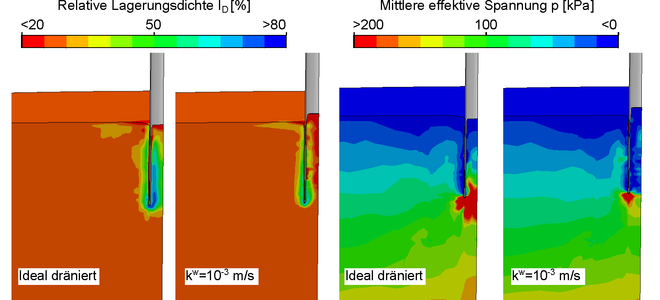HCA 4 PInS
Development of a method for realistic simulation of pile installation using the HCA model
As part of the "Climate Protection Program 2030," the installed capacity of offshore wind turbines is to be increased to 25 GW by 2030. This will be achieved not only by developing new wind farms but also through the planned market introduction of wind turbines with a capacity of up to 14 MW. The installation of these turbines must comply with strict environmental and nature conservation regulations. The currently common installation method of impact driving can only meet these requirements with the addition of extra technical solutions to reduce the noise of the driving process. A more environmentally friendly alternative installation method is the relatively low-emission vibrating pile installation. However, initial model and field tests have shown that the load-bearing capacity of vibrated piles is lower compared to driven piles. Common design methods using nonlinear spring curves (p-y curves) or the Finite Element Method (FEM) are typically applied without considering the actual installation process.
The goal of this proposal is to develop an appropriate numerical calculation strategy based on the so-called "Zipper method" in combination with a high-cycle accumulation model (HCA model), enabling a realistic simulation of the installation process and subsequent calculation of the (high-)cyclic lateral loads from wind and waves. The simulation of the pile installation will, for the first time, take into account the key installation parameters and provide an accurate representation of the pile-soil interaction. This includes, for example, the representation of the actual installation time and frequency, the number of load cycles, inertia effects, and partial drainage. The developed numerical method will be validated using model and field tests from the literature.
Based on this calculation strategy, analytical approaches will be derived to simplify the consideration of installation effects depending on factors such as the installation method, soil density, and drainage conditions in current "wished-in-place" FEM calculations. The resulting transfer of the findings from this project into practice enables engineers and authorities to account for the influence of pile installation during the preliminary design and dimensioning of monopile foundations.
Furthermore, the numerical tools developed in this project allow for a systematic investigation of pile installation, thereby supporting the development and evaluation of innovative installation methods.
Further information about the DFG project HCA 4 PInS can be found on the website.


